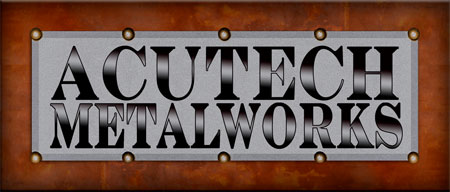Precision machining? We make it happen. Acutech works!
From the technology to the craftsmen, Acutech has your precision machining needs covered under one roof.
[band variation=”alternative” backgroundimage=”https://acutechworks.com/wp-content/uploads/metal-band.jpg” paddingtop=”10px” paddingbottom=”10px” inset=”yes”]
[gap height=”20″]
[row]
[column width=”one-half”]
One of the many services that Acutech offers is CNC machining. Acutech uses CNC machine milling and CNC machine turning to precisely shape metals including aluminum and steel. Our team follows strict quality control standards to ensure each piece meets client specifications.
What is CNC machining?
Different than rapid prototyping SLS (selective laser sintering), CNC machining ( for more information about CNC machine milling and CNC machine turning see below) is a subtractive process that is computer numerical controlled (CNC). Once the design is programmed in the computer, the CNC machine is capable of removing and sculpting the metal to with high tolerance and precision. At Acutech we monitor each machining project to ensure that you receive the best product.
Looking for online CNC machining?
Make the smart choice – Acutech. We handle your machining needs with upmost detail resulting in quality output. Then we ship the final product to you anywhere in the United States.
With Acutech the communication process is clear and streamlined. To put it simply, Acutech works! Call our team today at 406-892-4030.
[/column]
[column width=”one-half”]
[/column]
[/row]
[gap height=”20″]
[accordions]
[accordion title=”Learn more about CNC Machine Milling“]
A milling machine works by cutting material from the surface of an object, such as for a logo or indentation, using metal bits that are fixed in one place. Milling mach ines operate around an x-axis (side to side), y-axis (vertical), and z-axis (height). A vise fixed to the table in the x-axis holds the material in its appropriate place so that the cutting tools can cut out the desired shape, which can range from flat surfaces, grooves, shoulders, inclined surfaces, dovetails, and T-slots. A milling cutter, the rotating cutting piece, works to form the alteration on the material and the cutter is controlled within .001″ for precision metal cutting. They are run either manually or via a computer numerical control (CNC) from a computer system.
ines operate around an x-axis (side to side), y-axis (vertical), and z-axis (height). A vise fixed to the table in the x-axis holds the material in its appropriate place so that the cutting tools can cut out the desired shape, which can range from flat surfaces, grooves, shoulders, inclined surfaces, dovetails, and T-slots. A milling cutter, the rotating cutting piece, works to form the alteration on the material and the cutter is controlled within .001″ for precision metal cutting. They are run either manually or via a computer numerical control (CNC) from a computer system.
Milling cutters work by going one of two directions. Conventional milling works by sliding across the surface of the material until enough pressure is built to break the surface and begin the metal cutting process. In climb milling, the cutter begins shaving away material at the largest point of the cut and works towards the smallest. These are two cutting methods that vary the process of how a milling machine works. The method that is used is usually chosen depending on the metal that is being cut- harder metals generally need to be cut at slower speeds, while softer metals are usually cut at higher speeds.
[/accordion]
[accordion title=”Learn more about CNC Machine Turning”]
Turning is a process in the metalworking business that involves putting a metal piece on a turning lathe. The turning lathe enables the machine operator to cut parts that are symmetrical around a single axis. Oftentimes turning lathes are used in wood turning to sculpt wood pieces into symmetrical parts such as table legs or posts. In metal working, a turning lathe can be used to make complex items such as engine parts and wind turbine parts.
A turning lathe works by moving the piece of material around one point, creating a spinning motion. While the material rotates, tools cut along the outside, creating grooves, tapering, or profiling the material. A turning lathe can also work from the inside of the material using a process referred to as boring. This hollows out the piece symmetrically.
As with other job shop machine tools, the turning lathe can be controlled manually or with CNC. Using CNC programming cuts down on labor time and ensures precise and accurate results. Plans and specifications from a CAD program are uploaded on the turning machine, where a skilled operator programs and supervises the process.
[/accordion]
[/accordions]

